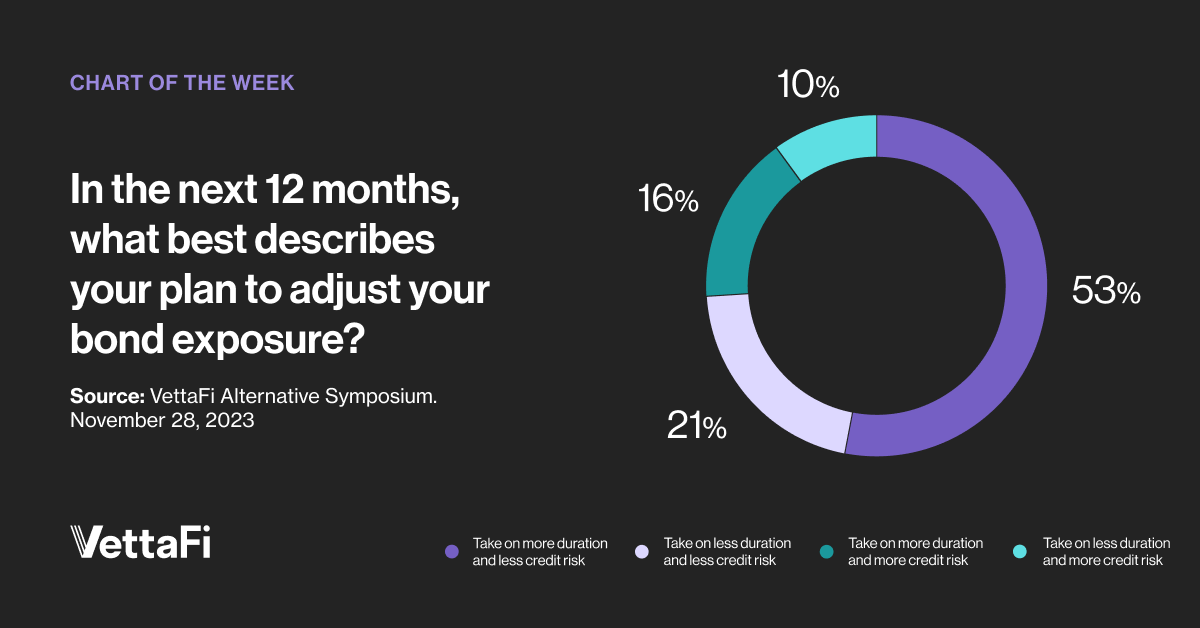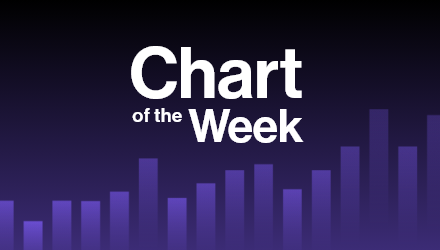Many advisors and investors in 2023 have turned to fixed income ETFs with an average duration of less than one year. Taking on very little interest rate risk through duration has been rewarding as well. However, as the Fed appears to many to have ended its rate hiking program, and may be cutting rates in 2024, sentiment is shifting.
This week, VettaFi hosted an Alternatives Symposium. More than 700 attendees heard from industry experts about commodities, cryptocurrency, managed futures, private equity, and more. While much of the discussion steered away from the bond market, we were able to gauge risk tolerance. We asked: “In the next 12 months, what best describes your plan to adjust your bond exposure?”
Most of the respondents (53%) selected “take on more duration and less credit risk,” while another 16% chose “take on more duration and more credit risk.” Among the other respondents preferring to take on less duration risk, taking on less credit risk (21%) was more popular than more credit risk (10%).

Take on More Duration With Little Credit Risk
The SPDR Bloomberg 1-3 Month T-Bill ETF (BIL) pulled in $10 billion of new money thus far in 2023. BIL has a 30-day SEC yield of 5.3% and a year-to-date total return of 4.4%. However, the SPDR Portfolio Intermediate Treasury ETF (SPTI) might be a good alternative for those looking to take on more duration but not take on more credit risk. SPTI’s average duration is 5 years, and the fund has a 4.6% yield. SPTI has a minuscule 0.03% expense ratio adding to its appeal.
Meanwhile, the US Treasury 3-Month Bill ETF (TBIL) gathered $2.5 billion so far this year. Its peer, the BondBloxx Bloomberg Six Month Target Duration US Treasury ETF (XHLF), added $1 billion. Both ETFs launched in 2022 and those willing to try out relatively new funds were rewarded. TBIL and XHLF gained 4.6% and 4.3%.
Thus far, there has been far less interest in the intermediate-term single Treasury bond products from the same providers. However, we think that funds like the US Treasury 3 Year Note (UTRE) and the BondBloxx Bloomberg Five Year Target Duration ETF (XFIV) will gain traction over the next year. These ETFs provide advisors and clients with the ability to manage their enhanced interest rate risk with precision.
Active Bond ETFs Willing to Take on More Credit Risk
Another popular ultra-short-term bond ETF this year has been the PIMCO Enhanced Short Maturity ETF (MINT). The actively managed fund added $1.6 billion of new money and rose 5.7% in value. For those willing to take on more duration and more credit risk, PIMCO might also have a good active alternative.
The PIMCO Active Bond ETF (BOND) has some exposure to U.S. government bonds, but the majority is split between securitized debt and investment-grade corporate bonds. The fund sports a 5.3% yield and has an average duration of 6 years.
While many ETF investors previously sought to limit their interest rate risk in 2023, the approach has not been universal. The iShares 20+ Year Treasury Bond ETF (TLT) has been the most popular bond ETF this year. TLT, which takes on significant interest rate risk and has declined in value as a result in 2023, gathered $22 billion. Yet, if the Fed does indeed cut rates, those who held onto TLT will likely benefit.
For more news, information, and analysis, visit the Institutional Income Strategies Channel.

